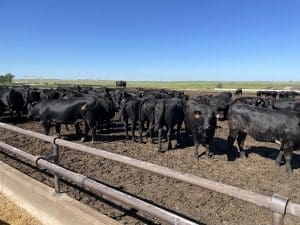By David MacKenzie Contributing Editor

Editor’s Note: David MacKenzie, beef and sheep director at HARBRO Limited, leads a team charged with changing and improving the nutritional and financial performance of beef and sheep operations in the United Kingdom. He recently toured U.S. cow-calf operations and feedyards. Part 2 covers his observations of the differences between U.S. and U.K. cattle feeding.
The first thing that hits you whenever you visit a U.S. feedyard is the sheer magnitude of livestock finishing on such a large scale. In reality, all of the United Kingdom cattle could be handled by these companies. One fundamental difference that I felt was that the feedyard manager was not only managing livestock and the nutritional inputs for the yard, but they were also running a large-scale feed mill right in the middle of the site. From a U.K. perspective, these have always been treated very separately. The other major difference from a European angle is that most finishing-yard animals are housed under roof. The erection of these buildings is at considerable cost and has quite a varied aspiration on payback.
We have come out of a subsidy-driven food production system where food security has been positioned as a priority for the farming groups by the industry. However, the governments have established a strategy of public money for public goods. In order for landowners and ranchers to gain any government support, they must allow public access to walkways, pull back from food production and create wildlife habitat.
The emergent picture particularly coming out of the United Kingdom is to have fewer cow-calf producers; we have seen a 15 percent reduction in beef cows over 10 years. But they have the void filled with beef from dairy calves and new trade deals set where it gives an opportunity for countries like Australia to supply beef into the United Kingdom. It seems that regulation and political support for the U.S. beef industry was always a topic of discussion. When discussing the regulation that is being threatened and implemented in some countries, one rancher said to me, “You can’t lose control of your industry like that.”
In the United Kingdom, the dedicated cowboy going through each pen and inspecting each lot of cattle was something that was traditionally done when we had more farmhands looking after livestock. As units have grown and more recognized feeding technologies have developed, rushing to get on with the next job has meant that it’s been a challenge to pick up the early signs an animal is getting sick.
My big take-home message was a very simple one – water-trough hygiene. Having people employed solely not only to empty water troughs but to clean them has been something that I have discussed with every single farmer I have met since returning home. Another key take-home for me was the predicted finishing date for each animal. Over here, most units would be working on a set number of days (usually between 90 and 100 days) to finish for animals around 850 pounds, and gaining about 3 pounds per day. Our carcasses yield from 53 to 56 percent. I believe it would be more like 63 to 64 percent in the United States. This was a different mindset for me.
In Europe, using hormones and certain feed additives like monensin and tylosin have been banned. The considerable performance difference in the conventional system for the money spent really gave the United States a considerable advantage.
Corn was a fundamental mainstay of the feedyards I visited. Fresh, steam-flaked was fed every day as part of the ration. In the United Kingdom and Europe, we would be using barley and wheat with maize, either grown in hotter climates or imported. Our cereals are dried and more crushed, with a lot being treated to ammoniate the grain and fed with a little added molasses. Cattle are given free access to straw for roughage.
Apart from the pneumonia challenge we face, liver abscesses and brisket disease were commonly discussed. Liver abscesses were reported to be over 20 percent of beef-bred animals and 30 to 40 percent in beef from dairy-cross and purebred dairy steers. This is at a far higher level than in the United Kingdom.
Like the U.K., the U.S. is seeing buoyant prices. A typical 880-pound carcass is worth $2,500, which four years ago was $1,750. Certainly, marbling came into the conversation from both cow-calf producers and feeders, and is considered a responsibility to all in the chain to ensure the eating experience of U.S.-produced beef. Unfortunately, I cannot report that this is the same in the United Kingdom. We currently have no evaluation and premiums paid for any marbling and one of the main criticisms of an inconsistent eating experience that I feel the U.S. industry is more aligned and more focused on than we are.







